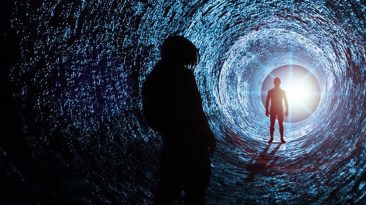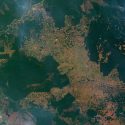635 light-years from where you are sitting, way out in outer space, lies a planet. The first planet to be discovered inside the habitable zone of a Sun-like star. Its name is Kepler 22-b. When a planet is located within a star’s habitable zone, it means that there is a chance that liquid water exists on its surface. And where there’s water, there’s also the possibility of life. Human life.
How long would it take you to get to Kepler 22-b? What would the weather be like over there? And why would you need to get jacked before arriving on this new planet? Kepler 22-b is what scientists call an exoplanet. It’s a planet outside our Solar System. Spotting an exoplanet like Kepler 22-b is often not easy.
The bright glare of the stars they orbit tends to keep them hidden from our telescopes. What did scientists come up with to get around it? Looking at the stars themselves to see if they can find anything unusual about them. They spotted Kepler 22-b using what’s called the transit method. They watched Kepler-22, the star this exoplanet orbits around, and noticed that its brightness changes over time.
That was because Kepler 22-b was blocking the star’s light. With this, scientists were able to learn both the size of 22-b and how it orbits. And it looks like this distant space rock can become our next home.
Okay, but what do we really know about Kepler 22-b? Its mass is 36 times that of Earth with a radius 2.5 times larger than ours. One year in Kepler 22-b is 290 days. It’s also located 15% closer to its star than we are to the Sun. If Earth scooched over that close to our star, you’d be fried. Kepler 22-b, on the other hand, is lucky to have a sun that is remarkably similar to ours but also smaller and colder.
This close proximity to its star allows the planet to receive about the same amount of sunlight as we get over here. The temperature on Kepler 22-b could be around 15 to 22 °C (60-72 °F). Similar to Earth’s spring weather and quite habitable, if you ask me. But our galaxy can be a cruel place and not everything is good news. Some models suggest that Kepler 22-b is rotating on its side.
Kind of like our very own Uranus. This might sound insignificant, but it adds potential deadly complications. This would mean that its north and south poles are shrouded in either sunlight or darkness for half a year. This ain’t simply a matter of whether you’re a daytime or nighttime person. A world like Kepler 22-b spinning on its side means that temperatures could change from boiling to freezing.
Which wouldn’t be great for human life. I know. What a bummer. But don’t despair yet. Our galaxy is also big enough to include some hope. New studies show that Kepler 22-b might be covered in an ocean 50 m (164 ft) deep. And that ocean would be able to act as natural climate control, keeping the wild temperatures at bay. See, an ocean can store heat during the summer and release it during the winter, which results in a mild climate.
Like you needed another reason to live close to the water. But how would you even make it all the way to Kepler 22-b? I mean, even if you were traveling at the speed of light it would take you 635 years. Your best bet could be to hibernate through the trip inside a device that preserves your body way past its natural lifespan. Like cryogenic sleep.
NASA has already developed a cryosleep chamber that can lower an astronaut’s body temperature to as low as 32 °C (89 °F). This would trigger natural hibernation, during which catheters would provide your body with nutrients and remove any waste. But even in cryosleep, it would be quite the long, risky trip.
This leads us to the most dangerous part about this journey. All that remains unknown about Kepler 22-b. For starters, we still don’t really know what gravity is like there. It could be twice as strong as our planet’s. If that was the case, a 10 kg (22 lb) sack of potatoes would now weigh 20 kg (44 lb). Your body would also factor into the mix. Is your current weight 75 kg (165 lb)?
Good luck suddenly dealing with 150 kg (330 lb) of you. Just for safety, settlers such as yourself would need to bulk up. Really bulk up. Only through intense strength training would you increase your chances of being able to walk on Kepler 22-b. And once you got jacked on Earth, you’d have to figure out ways to preserve that muscle through all 635 years of light-speed travel.
But humans aren’t the only lifeform that would be affected by a stronger gravity. Plants brought from Earth for oxygen and nutrition might not survive on Kepler 22-b when you try growing them there. And if you brought any animals with you, they’d need to step up the evolution process. Higher gravity could lead to creatures developing additional legs to move around.
It could also determine the location and size of internal organs. But the mysteries don’t end there. Scientists still don’t know for sure that Kepler 22-b is even a rocky planet. It might be gaseous, similar to Neptune. Or it could be entirely covered with water. If you and other first settlers woke up from your cryosleep and found yourselves on a gas planet, that would be a downer.
You wouldn’t have a solid surface to even land your ship. Not to mention a place to set up camp. In that case, you and your crew would need to figure out how to build a cloud city orbiting the planet. If you landed on an ocean planet, a submarine town would be in order. Discovering Kepler 22-b is a rocky planet would be hitting the jackpot then, right? Not so fast.
Venus is also made of rock. And yet its dense atmosphere consisting of greenhouse gasses makes it uninhabitable, with scorching temperatures far too hot for liquid water. If this was also the situation with Kepler 22-b, our only chance at thriving on this exoplanet would be to employ robots that could build underground shelters.
The place where maybe, just maybe, the temperature might be cool enough for you to bear. Venus is also located inside a habitable zone. It just goes to show you that a prime location is no guarantee for human survival. And as exciting as it might seem to find other worlds to inhabit, our own Earth keeps being the perfect habitat for humanity. But sometimes the slightest change can shake its ideal balance.
Sources
- “Kepler-22B: Facts About Exoplanet In Habitable Zone”. Elizabeth Howell. 2017. space.com.
- “Could We Live On Kepler-22B, Like Raised By Wolves’ Human Colonists?”. Cassidy Ward. 2020. syfy.com.
- “Calculating Your Weight On Another Planet | National Schools’ Observatory”. 2022. schoolsobservatory.org.
- “In Depth | Neptune – NASA Solar System Exploration”. 2022. solarsystem.nasa.gov.
- “How strong is the gravity on Jupiter?”. 2022. coolcosmos.ipac.caltech.edu.



























